2024 ITG Conference Report - Day 2 - Wednesday, May 29
The 48th Annual International Trumpet Guild Conference - Anaheim, California (USA)
Special Daily Report • Compiled by Peter Wood
Photos by Daniel Kelly and Michael Anderson
Wednesday, May 29, 2024
Click here for more photos from the ITG Conference
Jonathan Bhatia Warm-Up Session - Rise and Shine with Efficiency
Jonathan Bhatia greeted a room full of early risers to an engaging warm-up session, titled “Rise and Shine with Efficiency.” As Bhatia described his approach to developing a warmup, he stressed the importance of refining the physical efficiencies of playing the trumpet through effective use of the airstream. Noting the significance of the air in all aspects of playing the trumpet, Bhatia led the group through exercises of long tones, breath attacks, flow and flexibility studies, wind patterns, and more. Encouraging participants to focus on the momentum of their airstream, Bhatia moved through more exercises of articulation, technique, and range building to provide a comprehensive routine. Bhatia’s session was a fantastic start to the morning, and his clear descriptions and demonstrations were a valuable tool for everyone involved. (Eric Millard)
Kayla Solomon - Tuning-Up Your Performance Utilizing Strength Exercises
Dr. Kayla Solomon delivered an in-depth and engaging presentation focused on body and mind wellness. Solomon’s positive and inclusive approach drew a nearly packed early-morning session with everyone on their feet participating in stretches and other body relaxation movements. During the session, Solomon was able to resonate with all levels of musicians - specifically the “comeback” players - who did not hesitate to ask questions about Solomon’s findings. Some of the highlights came from audience participation that led to clarification of stretches, movements, and positive mental approaches to playing the trumpet. The fresh perspective on body and mind wellness that Solomon brought to her presentation left the attendees feeling relaxed and eager to implement these ideas in their own practice. (Benjamin Dubbert)
Karl Sievers - The Teachings of William Adam
Karl Sievers, principal trumpet of the Oklahoma City Philharmonic, studied with William Adam for eight years. Sievers’ presentation on Adam’s teaching focused on the power of the mind to control kinesthetic response. Adam’s teaching was sound-centric and allowed players to find freedom. “THE sound” comes from energized breath, freely delivered, with follow-through and musical imagination, allowing the player to be in phase with the trumpet. This results in rejuvenated chops, effortlessness, and great sound, allowing the player to find a state of elevated energy. William Adam worked on the whole individual: personal character and performer. Adam was dedicated to modeling, up to seventy hours a week, focusing on “THE sound” and not on peripheral distractions or the physical and technical parameters of trumpet playing. Sievers recommends carving out your best time of day for practicing and dedicating your freshest mental energies to improvement and aural development. (Joe Cooper)
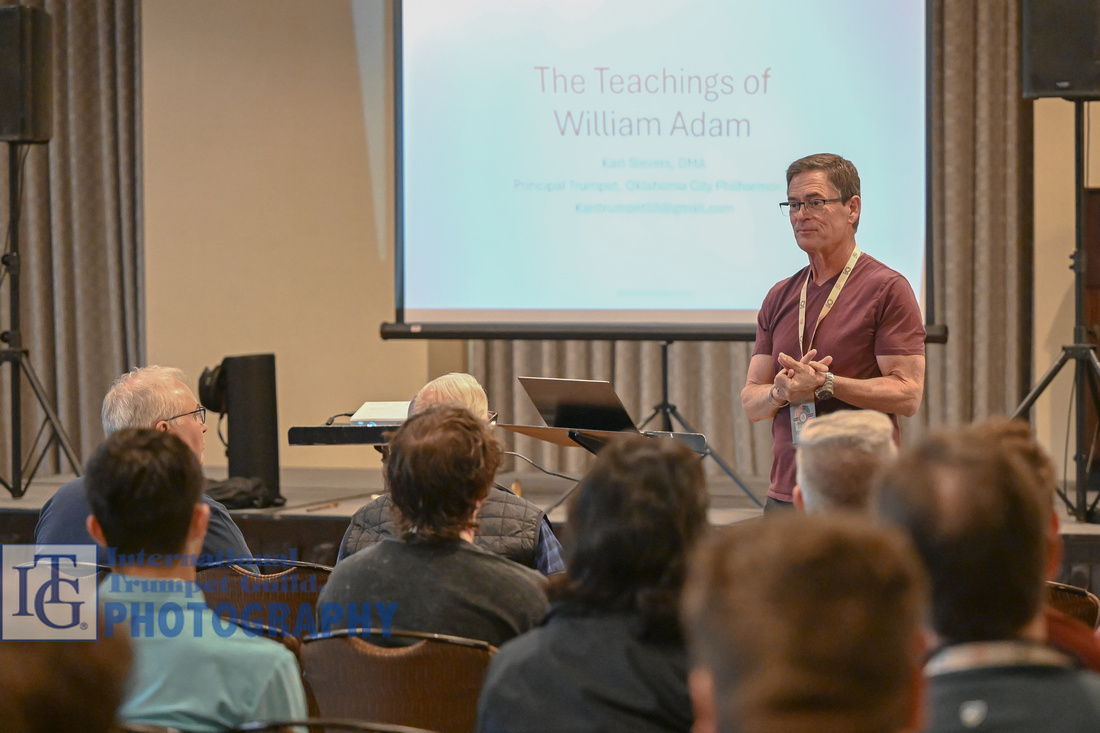

Bruce Whisler - Pharmaceutical Causes for Embouchure Weakness
Dr. Bruce Whisler, music professor at Clemson University, explored some common medicines and foods that might cause embouchure weakness. Basing his talk on his own experience, he relayed his embouchure struggle that affected his trumpet playing and led to his suspicion that cholesterol-lowering statins and aspartame were the culprits. After he stopped using both of these substances, his embouchure began to regain muscle tone and strength, so he recommended more research into how these substances may negatively affect brass players. After his talk, he shared his bibliography of research and took questions from the audience. (Stanley Curtis)
Nancy Taylor - Healthy Chops: The Science Behind Why Our Chops Behave as They Do and Evidence-Based Practices for Chop Management
Trumpeters attending Nancy Taylor’s session received valuable, applicable information on how to gain endurance, foster longevity in one’s career, and have a more reliable experience on the trumpet by exploring the balanced embouchure. Backed by a degree in occupational therapy, Taylor provided participants with exercises and information to help tackle one of the more challenging aspects of playing the trumpet – inflammation due to, for example, excessive pressure and hormonal fluctuation. She shared that we need the inflammation that occurs, which was a clear discovery moment for the trumpeters present. Advil, as it turns out, interrupts the swelling process, which is not good for muscle tissue recovery. So, what can we do to assist in the process of tissue swelling recovery? Long tones! Participants left with a newfound freedom of what they might do to assist in achieving healthier chops. (Sarah Stoneback)
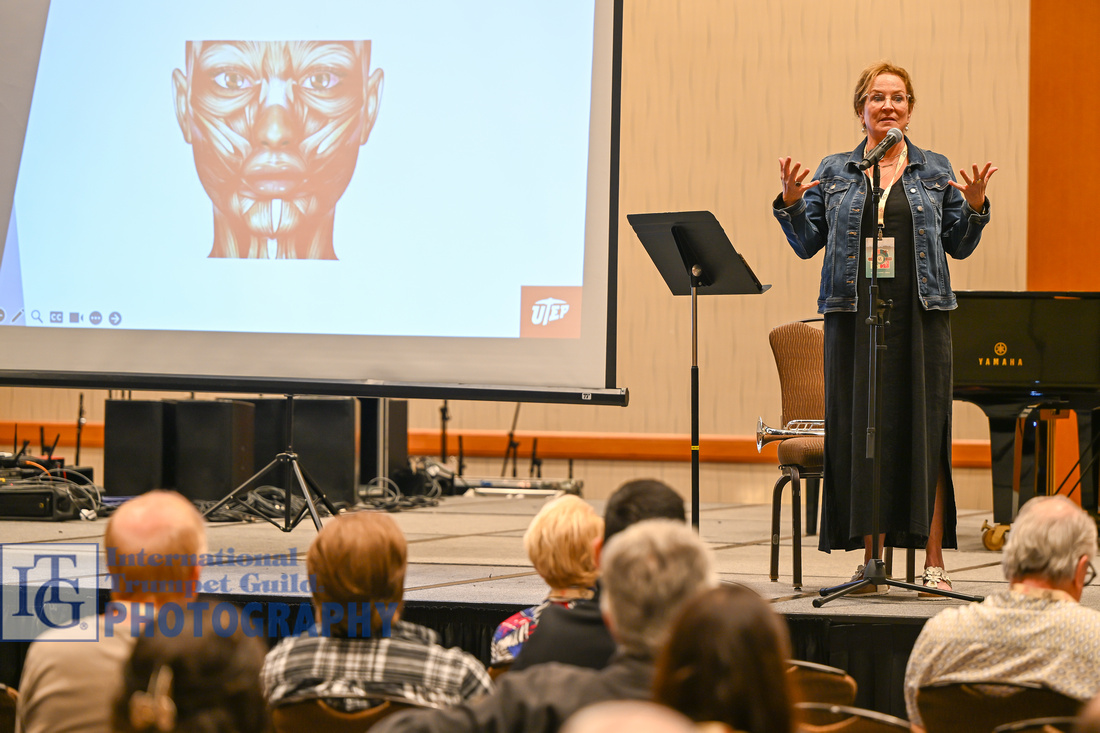

Adán Delgado Recital
Showcasing Spanish music for trumpet and piano, Adán Delgado and Miriam Hickman created a beautiful and thoughtfully well-crafted program with a variety of composers and styles that allowed him to fully display his singing sound. Ricardo Mollá’s “Metamorphosis” opened the program with an ethereal, misty texture that segued to full musical landscapes highlighting both performers. Javier Martínez’s “Go for it” was full of dance-like motifs and lyrical melodies that were traded between performers and continued to showcase the musical sensitivity of the duo. Written for the great Maurice André, Salvador Chulia’s Adagio was a gorgeous display of lyricism. The remainder of the recital consisted of a variety of compositions from film music by Juan Zapata to familiar melodies by Manuel de Falla. Delgado was joined by José Sibaja for Astor Piazzola’s “Milonga del Ángel,” in addition to Neeme Ots for Rafael Méndez’s arrangement of the trio “The Brave Matador,” the recital ended with an exciting flair and celebration of Spanish music. The entire recital featured a wide variety of tone colors from Delgado, all with the same golden, resonant core. (Will Koehler)


Jeff Bunnell - Trumpet Arranging Unleashed: The Secrets behind the LA Trumpet Ensemble CD Homage
This presentation, hosted by Jeff Bunnell, was an energetic and educational session that featured the Los Angeles Trumpet Ensemble’s CD, “Homage.” As attendees listened and followed along with the scores displayed on the screen, Bunnell provided narrations to cover the tools used to bring his arrangements to life. The magic of this class unfolded when questions started to fly after each recording was played, which turned into a miniature discussion each time. The music covered included some familiar film music such as the theme from “Superman” and “Silverado,” along with such refreshed jazz standards as “Joy Spring” and “Give It One.” Bunnell left his attendees with a new palette of ideas and tools, along with endless possibilities, with which to experiment. (Benjamin Dubbert)
Wind Band Excerpts Competition Finals
The Terrace Ballroom was filled with a supportive audience for the final round of the Wind Band Excerpts division of The Ryan Anthony Memorial Trumpet Competition. The demanding repertoire list was a true test of technique, endurance, and musical expression. The three exceptional finalists were Mason Stokes from Baylor University, Nathan Coffman from Duquesne University, and Johniel Najera from Baylor University. The list included standard excerpts like Gershwin’s “American in Paris” and John Williams’s “Summon the Heroes,” as well as band staples like Sousa’s “Hands Across the Sea” and Persichetti’s “Divertimento for Band.” Each performer delivered their own interpretation of Taps and were able to showcase their virtuosity on Herbert L. Clarke’s “The Debutante.” All three finalists played with great poise, conviction, and musicality. (Nick Volz)
New Works Recital #1
The first New Works Recital of the Conference featured ten works. The recital opened with Jack Ballard’s “Cannon Father” for three trumpets (wonderfully played by Joey Tartell, Brian Walker, and Chloe Swindler). The imitative three movements were inspired by fatherhood. Daniel Kelly (trumpet) and Libby Vanatta (piano) performed Alan Theisen’s “Streets of Scarlet and Shadow.” This dramatic work, inspired by film noir soundtracks, was underpinned by Kelly’s graceful and brilliant playing.
Anne McNamara performed with great panache Logan Larson’s “Electric Thunder Dunk” for solo trumpet accompanied by an upbeat, electronic, fixed-media recording. The fourth piece on the program, Catherine McMichael’s “Maravillas de la Patagonia,” was sensitively performed by the Sapphire Brass (John Kilgore, trumpet; Eric Millard, bass trumpet; Katey Halbert, horn; and the composer on piano). This three-movement piece, inspired by the landscape of Patagonia, featured strong melodies with frequent counterpoint and piano figuration (as well as a brief recitation in the last movement by John Kilgore).
ITG board member Nadje Noordhuis performed Stephen Montalvo’s “Innovations 2,” a piece for solo trumpet and electronic effects. Noordhuis adeptly handled the demanding effects controls with her left hand while playing wonderfully, holding the trumpet with only her right hand. Vincent Reed wrote “Voyage of Gold” for trumpet ensemble (the first movement of a larger work called “Salt of the Sea”). Reed performed his work with Ellie Lundy, Kate Marcino, and Bentley Lankford (all students from Lipscomb University).
Trumpeter Amanda Ross played Remi Inari’s twelve-tone “Did you see the Dragon?” This piece starts with just a few notes, slowly adding additional tones as it progresses. Based on a Japanese short story, this unaccompanied work at times requires the performer to play multiphonics and use half-valve techniques to imitate the sound of a dragon. Matthew Howell’s “(un?)Fairly Ambiguous,” performed by Joseph Cooper on trumpet and John Salinas on alto saxophone, starts with slow drones and then progresses to various types of interruptions.
Trumpeter Sidney Shuler and his wife, clarinetist Pamela Shuler, commissioned the next piece, “Concoction,” for the 2023 ClarinetFest. Composer Franklin Piland found inspiration for this work from different types of black coffee. Pianist Kayla Liechty joined them in playing the first, third, and fifth movements (“black,” “espresso,” and “americano,” respectively). The last work on this recital, Evan Zegiel’s “Omen” for trumpet and fixed-media, was thrillingly played by trumpeter David Hall, who deftly handled the significant range, articulation, and technical demands of the piece, all the material of which was characteristic of heavy metal music. (Stanley Curtis)
Javier Gonzalez and K.O. Skinsnes - Connecting Extreme Range Through Modern Equipment and Innovative Techniques
Following the Eastern Michigan University Trumpet Ensemble’s incredible performance of Erik Morales’s “X1,” Javier Gonzalez and K.O. Skinsnes presented a detailed presentation on how to improve playing efficiency through studying acoustics and incorporating innovative practice routines. Skinsnes first addressed how the science of “relative intonation” and the use of “appropriate damping” can improve a player’s efficiency on their equipment. He further explained that modifying the trumpet/mouthpiece design and adjusting the damping creates a fuller sound that is more consistent, in tune, and efficient. Then, Gonzalez talked about his experience at Cal Arts, studying world music styles, and explained how it revolutionized his approach to leadpipe buzzing. His approach shifted to “muscle activation” and using the oral cavity to manipulate the pitch on the leadpipe, creating a fluid sound from pedal C to triple high C. This session was both enlightening and inspiring to all in attendance to explore new ways of improving their range on the trumpet. (Spencer Brand)
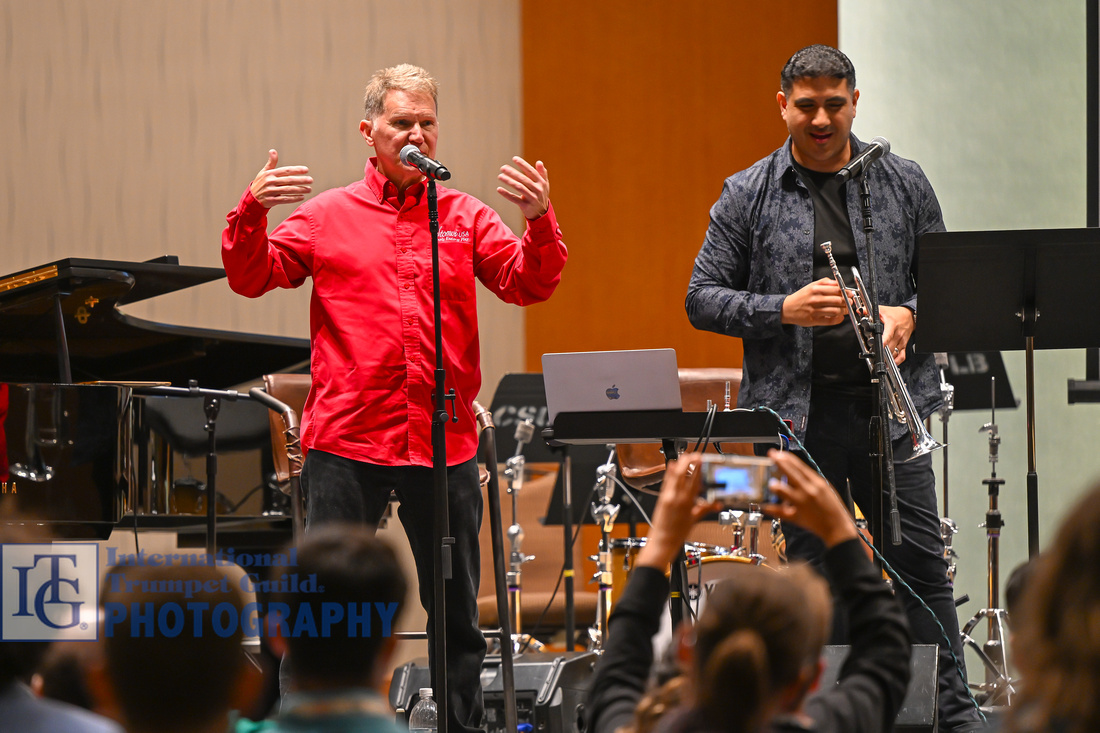

Niki Anthony, Wayne Bergeron, Vince DiMartino, Brian Walker, and Rebecca Wilt - Unstoppable You: Navigating Adversity with Grit
Following a joyous rendition of Joseph Price’s “Westward Ho!” by the Southern Utah University trumpet ensemble, Rebecca Wilt gave a brief introduction while adding some comedic relief to help with the transition. She then introduced the panel of speakers, including Vince DiMartino, Brian Walker, Wayne Bergeron, and Niki Anthony, to discuss the many challenges of dealing with major illness. Rebecca, Vince, Brian, and Wayne took turns sharing their own experiences while battling cancer and how it impacted their way of life and shifted their perspective to live in the present. Niki Anthony shared her outlook and advice as a caretaker and spouse to Ryan when he was battling multiple myeloma - lean into your inner stubbornness; denial can be your friend; be a good person; and set your path and have your desires because life will always have its changes, so be willing to start over. (Peter Nionakis)
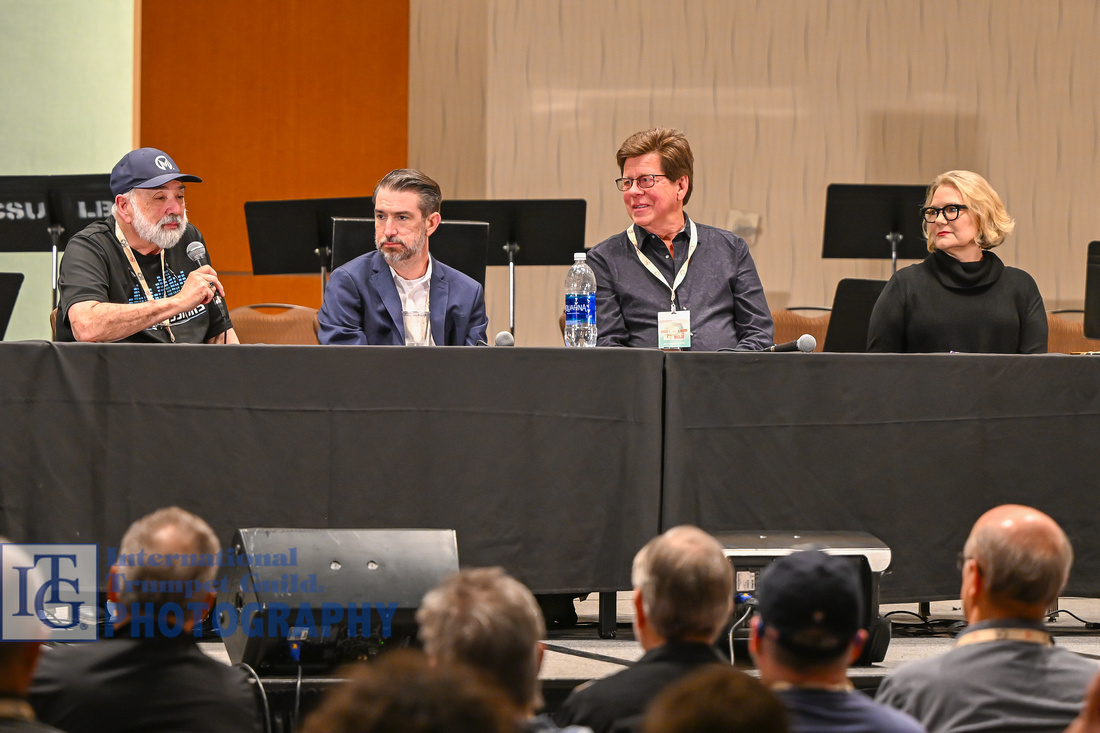

Orchestral Excerpts Competition Finals
The Orchestral Excerpts division of The Ryan Anthony Memorial Trumpet Competition was a display of great musicianship and preparation by finalists Chase Domke, Adam Warnke, and Xunji Yang. The three trumpeters performed seven excerpts from a list that contained Williams’s “Summon the Heroes,” Ravel’s Piano Concerto, Schumann’s Symphony No. 2, Bizet’s “Carmen,” Rimsky-Korsakov’s “Scheherazade,” Hailstork’s “An American Fanfare,” and Bartok’s Concerto for Orchestra. Xunji Yang was the first competitor and performed the list with great sound and vibrancy in every register and at every dynamic. Chase Domke showcased his beautiful tone and clear articulation. Adam Warnke was the last performer and demonstrated a gorgeous sound and ease of playing through both technical and lyrical passages. Afterwards, the judging panel held a short masterclass on the challenges of taking orchestra auditions and gave each competitor feedback on their performance. The jury was composed of Christopher Smith of the San Diego Symphony; Adán Delgado of the National Orchestra of Spain; and Merrie Klazek, former principal trumpet of the Thunder Bay Symphony. (Flint Angeroth Franks)
Huw Morgan Recital
An enthusiastic audience was on hand for the recital presented by Huw Morgan and Rebecca Wilt. The performance opened with a spirited performance of Verne Reynolds’ “Suite for Five Trumpets” by the University of Southern Mississippi Trumpet Ensemble. Morgan and Wilt then took the stage for a program of works by American composers and composers with strong ties to American music. The “American-born” selections included Rouse’s “The Avatar” and Alexius’s “Sonatina,” while the bulk of the program featured Ibert’s Impromptu, “Marietta’s Lied” from Korngold’s opera “Die Tote Stadt,” and Nadia Boulanger’s “Cantique.” Morgan took a moment to talk about each selection and its tie to American music. The program concluded with a collection of what Morgan called “only the popular numbers” from Stravinsky’s “Pulcinella,” followed by an encore, Sondheim’s “Send in the Clowns.” Morgan’s silky sound, beautiful phrasing, and impeccable intonation were on full display on flugelhorn and piccolo, C, B-flat, and E-flat trumpets. (Daniel Kelly)
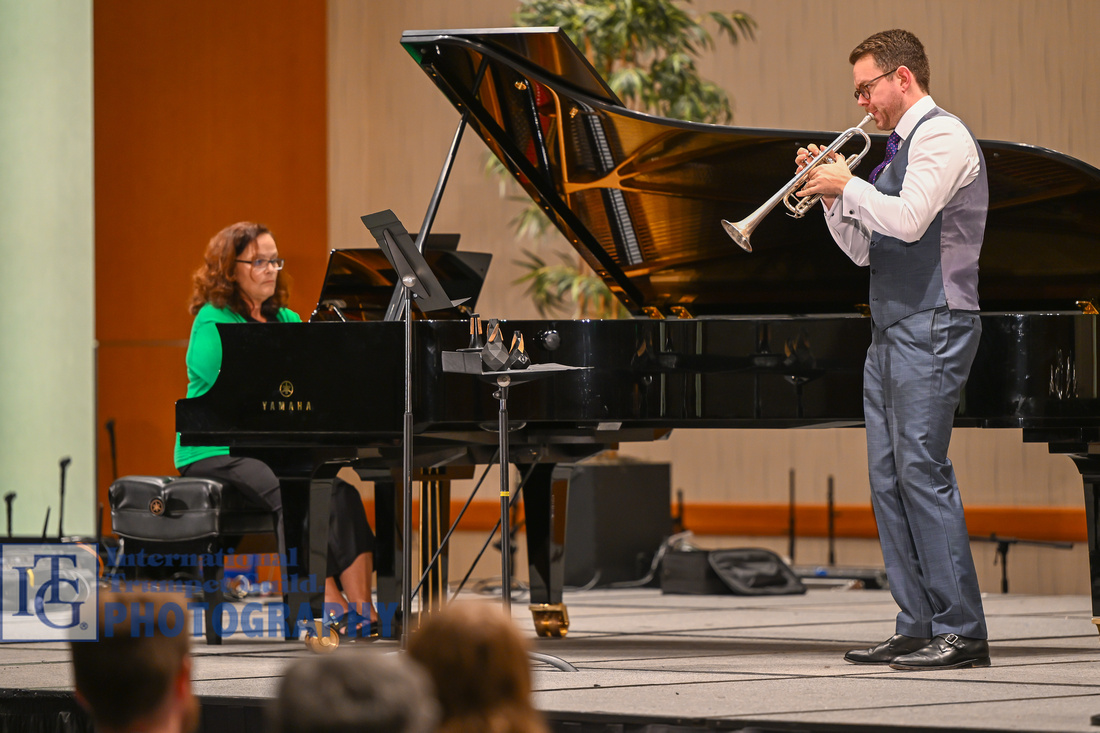

Evening Concert - Los Angeles Brass
With Jens Lindemann, Vincent DiMartino, Bria Skonberg, Rex Richardson, Steve Cunningham, and Jose Sibaja
The second evening concert of the Conference was a brass bonanza, starting with the North Atlantic Brass from Denmark's Royal Academy of Music. The quintet performed movements of Anthony Plog’s “Four Sketches,” Tielman Susato’s “Dance Suite,” and Thorvald Hansen’s Quintet with impressive technique and style.
In his characteristically “understated” style, Jens Lindemann took the stage to introduce the Los Angeles Brass, a sixteen-piece brass ensemble and rhythm section composed of top players from the LA area. The opening number, from Michael Kamen’s score to “Robin Hood,” set the tone for the evening, though it turned out to be the most classically oriented chart of the concert.
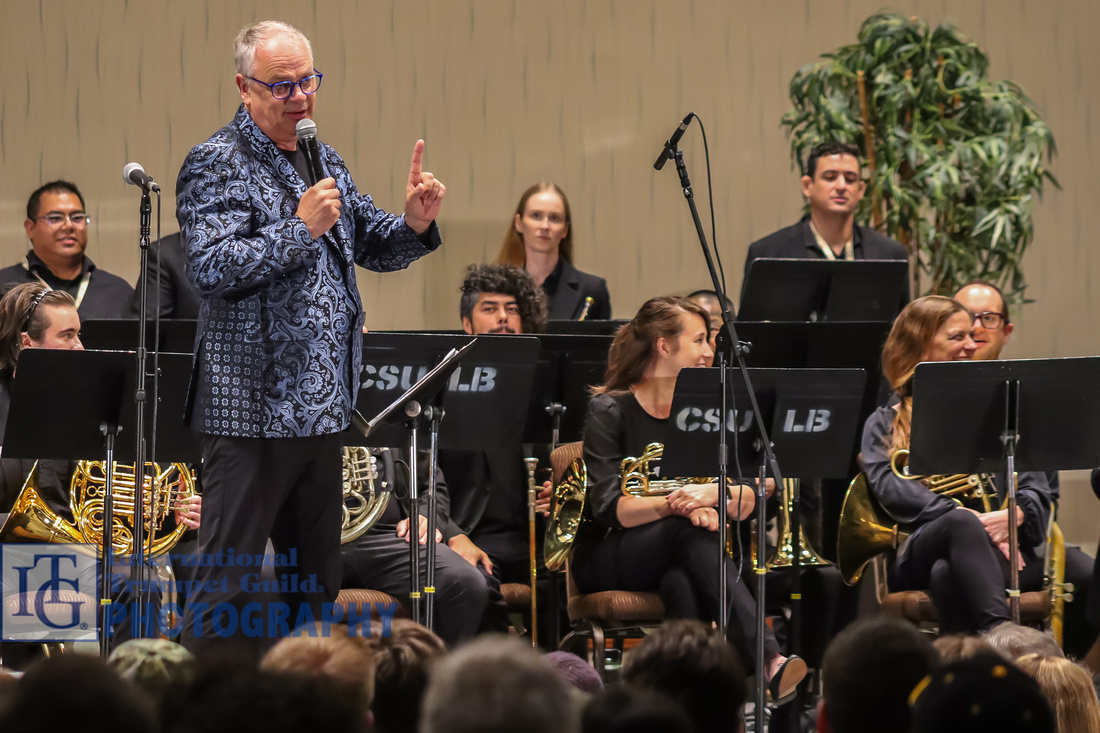



The ensemble was joined by Vince DiMartino, who took solo honors on Doc Severinson’s version of “Georgia on My Mind,” on which DiMartino’s sound, improvisational skills, and range were on full display. Bria Skonberg joined the group for an original ballad on which she played and took on the vocals with an abundance of cool style. The front line grew when Skonberg was joined by DiMartino, Rex Richardson, and Steven Cunningham for Skonberg’s take on a New Orleans second-line-style tune on which everyone took solo space, traded fours, and generally dressed to impress.
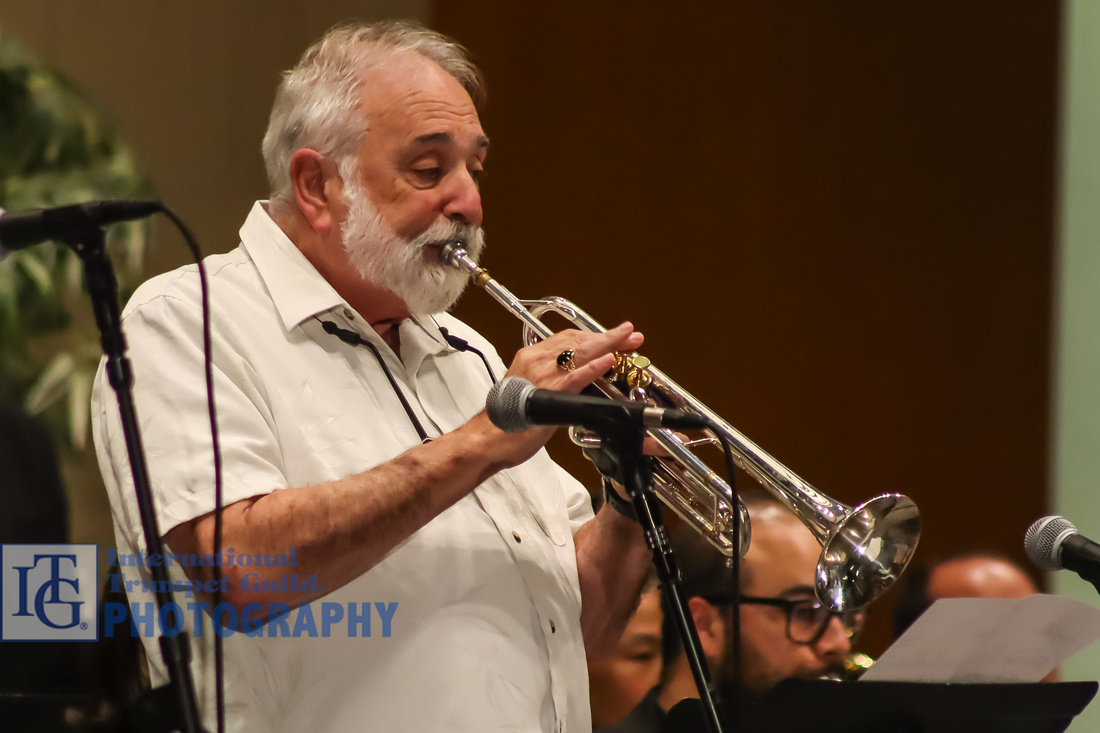

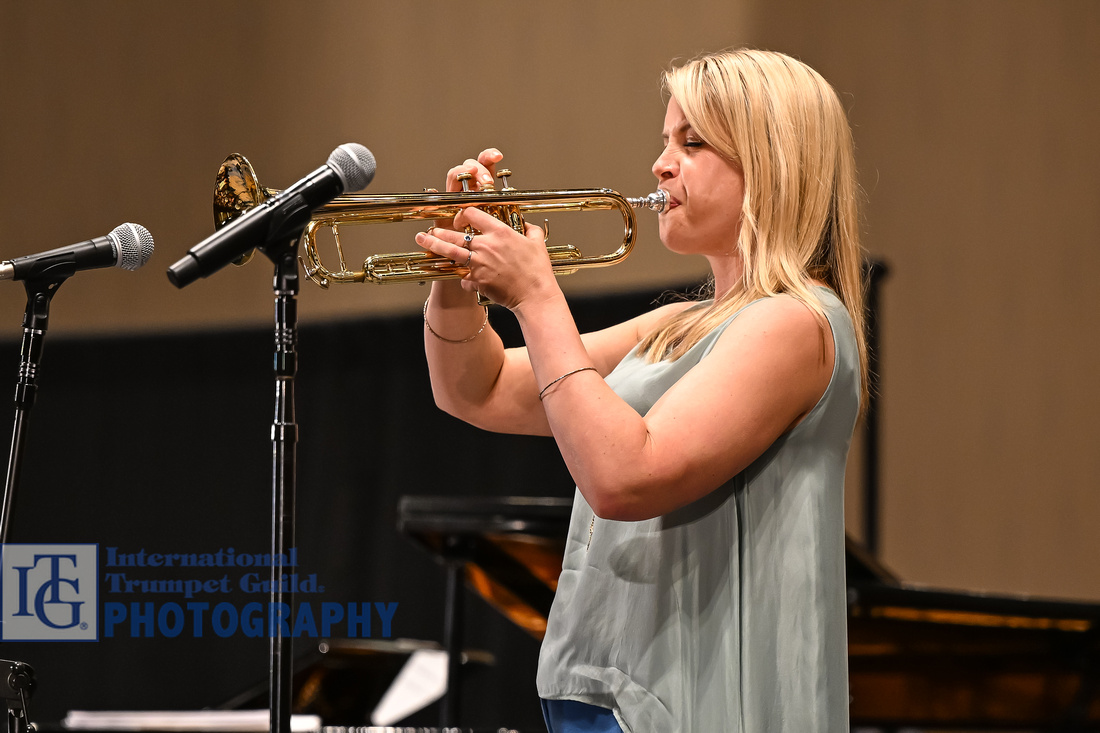

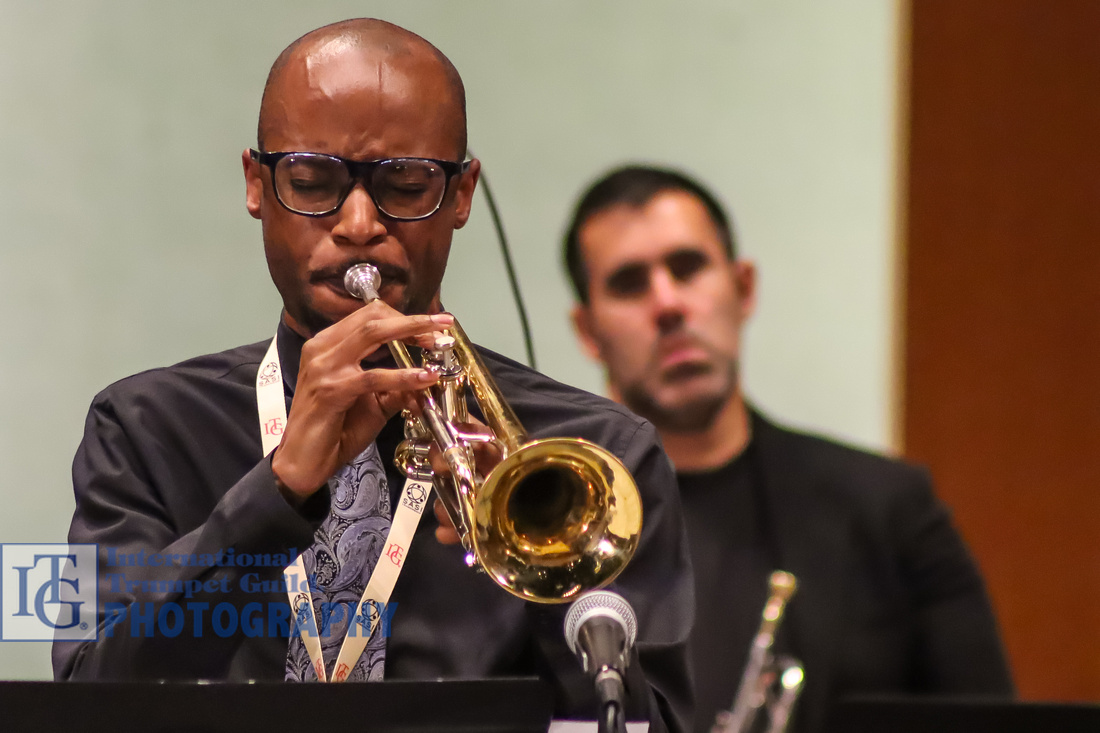

Lindemann traded his conducting duties for the solo spotlight on two movements of Allan Gilliland’s "Dreaming of the Masters III," a tribute to the trumpet’s contributions to pop, jazz, and Latin music. Lindemann explained that he premiered the piece with the Edmonton Symphony in 2010 and that it is also available for wind ensemble, big band, and brass ensemble. This brass ensemble version – and Lindemann’s performance – was certainly impressive and very well received.


Jose Sibaja and Rex Richardson performed "Caravan," a signature tune of the Boston Brass, because, as Lindemann joked, Jose was “too lazy to learn something new.” The duo ripped the room, for sure. Skonberg, Cunningham, and DiMartino joined Richardson to keep the Ellington vibe going with Don’t Mean a Thing, with Skonberg also tackling vocals, leading the audience participation scat singing, and showing her vocal chops on what appeared to be an unrehearsed vocal cadenza of high notes – always a crowd favorite. Lindemann and Sibaja joined the quartet for the final number, Peter Meechan’s "Song for Hope," to honor the life and legacy of the beloved Ryan Anthony. The Los Angeles Brass were fantastic in all styles, of course, and the concert was an exciting, non-stop celebration of brass attitude. (Daniel Kelly)
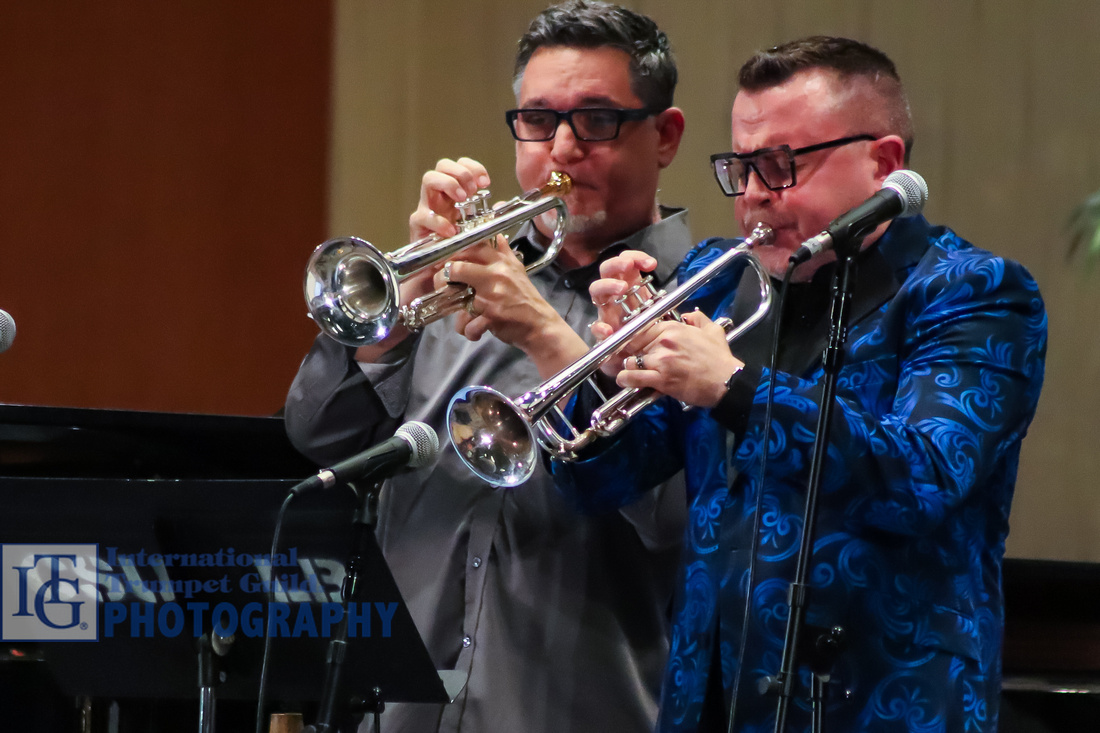

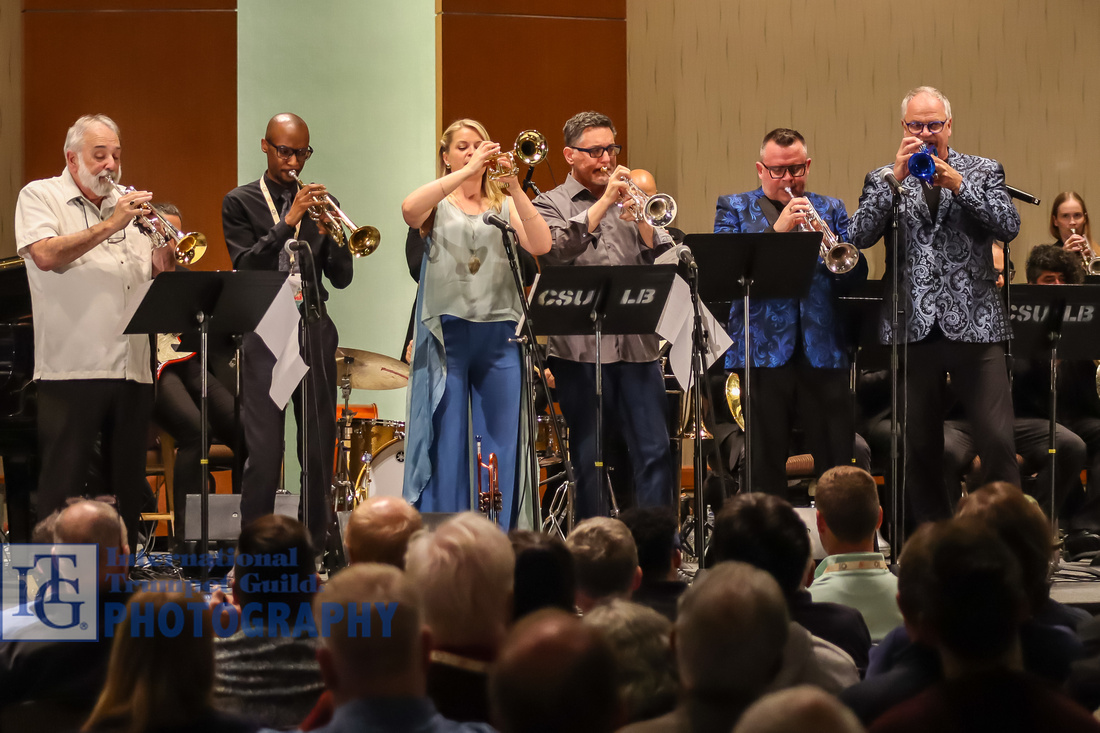

Jam session with Brad Goode
Brad Goode, associate professor of jazz studies at University of Colorado Boulder, hosted Thursday evening’s jam session. Creating a work-class experience, participants had the pleasure of collaborating with the conference jazz trio, who had just completed the preceding concert. The jam sessions provide an opportunity for participants to share their playing with other attendees, and this particular session allowed participants to play along with conference artist Brian Lynch. Goode emphasized creating a healthy environment for all participants, insisting that each soloist play only two choruses to accommodate everyone who wanted to play. Requested first was “Foot Prints,” a Wayne Shorter standard. Other requests included “Up Jumped Spring,” “I’ll Remember April,” “Black Orpheus,” and “Birks’ Works.” One of the most interesting and unique aspects of these sessions is being able to see the wide range of players - from high school students to active-duty military and seasoned professionals - joining together to celebrate the music they love. (Will Koehler )
“Song For Hope” Documentary Screening
Wednesday night’s screening of the film “Song for Hope” served as a powerful tribute to Ryan Anthony, an amazing man whose life was dedicated to his family and the art of music. The documentary immersed viewers in Ryan’s journey, showcasing his numerous triumphs and setbacks, from his profound connections with loved ones to the global community he fostered through music. Some of the highlights of the film were the touching depictions of his dedication to his family, the deep friendships he cultivated, the healing ability of laughter, and the transformative power of music in his life. This captivating documentary is available for streaming on Tubi, Apple TV, YouTube, Sling, and Amazon Prime. For further details, please visit the CancerBlows website (http://cancerblows.com). (Benjamin Dubbert)
Click here for more photos from the ITG Conference